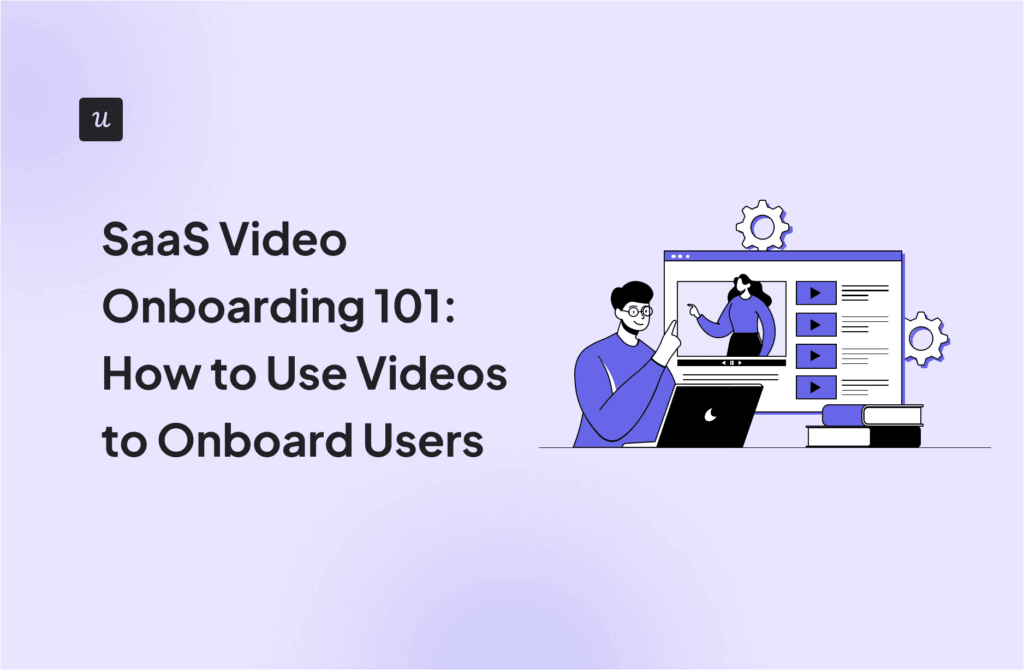
Onboarding is the most delicate and critical moment in your SaaS sales process.
Yes, the user has decided to sign up and give your software a test drive. But a rocky onboarding experience can cause users to abandon ship at the very last second, almost after the sale is complete.
Adding onboarding videos (watch our YouTube video here on How To Get Started With Userpilot) into the mix can deliver a smoother experience and even convince more users to try out your software. Ultimately, this means more long-term adoption and more revenue growth.
Get The Insights!
The fastest way to learn about Product Growth, Management & Trends.
Why use customer onboarding videos for SaaS?
The overarching argument for video is that most people are visual learners. People retain more information from video than from any other media. That’s why video marketing is so popular for helping new users understand products and services.
You’ve probably heard all this before. But there are even more reasons — SaaS-centric reasons — to use onboarding videos.
From a SaaS perspective, the real power of onboarding videos is that video dovetails perfectly into any product-led growth marketing strategy. And onboarding videos are especially powerful if you’re using a more traditional marketing approach.
First, onboarding videos help you get more new users.
Most people are not early adopters. The average person prefers what’s familiar. Even if you’re offering a freemium version, many potential users are going to be skeptical of the new tool. And you have to get over the account-creation hurdle.
Nobody likes creating new accounts. We’re all wary of giving out our email address to businesses. Creating new passwords is a headache. And diving into a new tool causes a dip in productivity, because new users must spend time learning how to use your software.
An onboarding video helps get more people over this hurdle because it shows new users what the initial experience will be like before they create an account. You can call it ‘pre-boarding’ if you like.
People are naturally afraid of the unknown. Case in point: according to marketing expert Gary Halbert, direct response conversions increase when you’re very specific about what is going to happen when the customer takes the next step in the sales process. Transparency matters.
An onboarding video gives prospective users that peek behind the curtain they crave. They can see exactly how easy it is to start using your software — and what quick wins they can get — before they create an account.
Without an onboarding video that potential users can watch before they create an account, you’ll see a pretty sharp drop-off at the account creation stage, simply because you’re asking people to go against their natural fear of the unknown.
Onboarding videos also help reduce new user abandonment.
Even if you have an onboarding process built into your software, people will usually only remember the steps they took to get that first win with your software. Or they’ll just click through the onboarding walkthrough steps without actually reading them. All of the other amazing software features will be forgotten.
At some point during their early experiences with your software, most people will need a refresher on certain features.
You can easily deliver them in-app in the form of microvideo (short clips of no longer than 30 seconds) embedded in tooltips and slideouts!
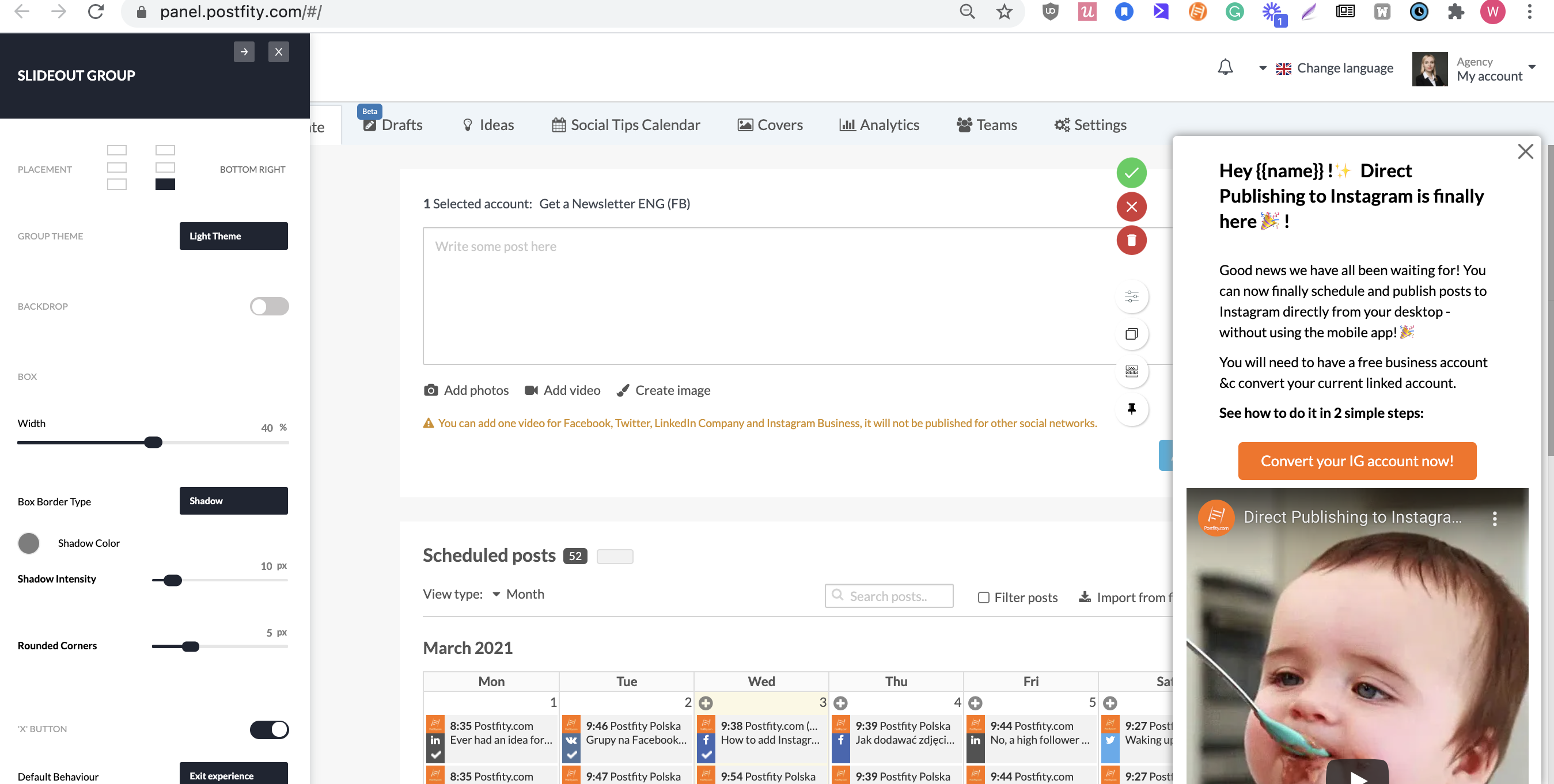
Would you like to easily embed microvideos into your in-app experiences? Let us show you how to do it easily with Userpilot!
With our native mobile SDK, you can create targeted onboarding flows using slideouts, carousels, and push notifications without writing extra code.
Video is an accessible way for them to get the information they need, when they need it, so they can achieve that next quick win. It’s certainly faster than going through the new-user onboarding walkthrough again.
You can also break your onboarding video into several smaller videos that focus only on a single feature or process within your software. This makes it even easier for users to reference your onboarding videos.
Where should you start?
Here’s the step-by-step playbook for your very first onboarding microvideos:
1. Record a 10-second video of yourself just saying hello and how excited you are to have your users here + “let me show you how to [insert your user’s job-to-be-done] in less than 30 seconds!”. Embed the new video in your welcome screen (you may need to record a few versions if you cater to different personas with different JTBD).
2. Pick two-three key activation points and build tooltips around them.
3. Record a few 15-second videos showing users how to perform each key action and embed these new microvideos in the tooltips.
You can also A/B test this new flow with microvideos vs. your default flow in Userpilot to see which one results in a higher activation rate.
Ultimately, when the help they need is easily accessible, new users are less likely to retreat back to their old, familiar tools.
Finally, onboarding videos help you achieve your ultimate SaaS goal: widespread adoption.
Onboarding videos help retain new users, and user retention leads to more widespread adoption. If you can attract more new users and turn them into long-term users, you win. Period.
How to make effective customer onboarding videos for SaaS
Creating onboarding videos is actually very easy.
Assuming you already have an onboarding process, creating an onboarding video is as simple as putting that process into video format, adding captions or a voiceover, and capping it with an intro and outro.
However, there are a few less obvious things that you’ll need to do (and not do).
Make sure your video shows how to do things, not just what to do.
An onboarding video that covers the account setup and features from a high level is good. But just telling a user they can do something isn’t as good as being very specific about how to do that thing.
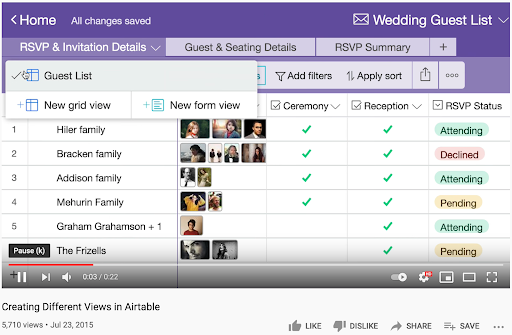
Even if it makes your video a bit longer, be sure to include very specific instructions for completing every step of the onboarding process.
Avoid creating a marketing video and calling it an onboarding video.
A video for Dropbox Paper has been making its way around as an example of an outstanding onboarding video.
…But it’s not an onboarding video. It’s a marketing video. An excellent marketing video, but still a marketing video.The fact that it’s being touted as an onboarding video shows that there is some confusion about what an onboarding video actually is.
Here is a simple check to determine if you’ve created the right video for the job:
If your video ends with a call-to-action to create an account, or if it feels like it should end with that call-to-action, it’s not an onboarding video. It’s a sales video.
Your onboarding video is squarely aimed at people who’ve already created an account. So you shouldn’t need to prompt the viewer to create an account at this point.
Include information about how to get more help.
Occasionally, people will have questions that you didn’t answer in your onboarding video. Or they’ll simply need a bit more instruction. And of course, there will be the users that have unusual circumstances to deal with.
As a standard outro in all of your onboarding videos, it’s smart to include your customer service options and a link to your FAQ page. That way, users can watch any one of your onboarding videos and find out where to get more help.
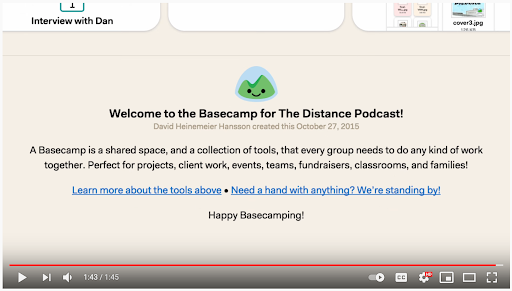
Help new users make the most of your software in their working environment.
There are two sides to helping new users integrate your software into their lives:
- Helping new users integrate your software with the other tools they use.
This one is self-explanatory. New users need to know how to connect all their tools into a coherent system. And they need to know how to add your software to their existing stack. Otherwise, they might abandon your software because they can’t figure out the integration processes, which can be complex.
- Establishing patterns of use.
People are creatures of habit. Even if your tool is extremely useful, people will revert back to their old systems out of habit, even if those systems are less efficient. Use your onboarding videos to help people establish patterns of use for your software so they can start building new habits.
For example, there is a series of videos on YouTube that shows new users how to do things in OmniFocus.
But the real power of these videos is that they also show new users how to make a habit of using OmniFocus by starting with small, simple tasks like vacuuming the house.
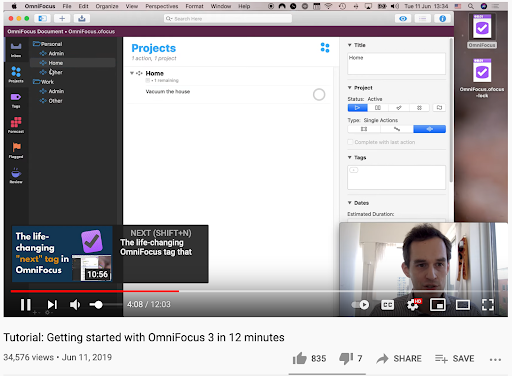
Adopting a new tool can be challenging. The last thing you want is to lose new users because they keep popping open their old software out of habit.
Onboarding videos are an invaluable opportunity to lay the groundwork for new habits until ultimately, your software becomes indispensable.
Personalize your videos.
If you look, there’s a person on screen in many onboarding and tutorial videos. Usually they’re down in the corner. But sometimes the video is more centered on the person delivering the information.
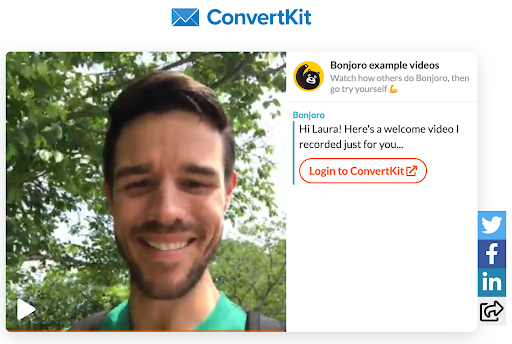
This is a good tactic because people like buying from, and being helped by, real people. There’s a reason why retail stores still exist, despite the efficiency of online shopping.
In the ConvertKit example above, the company personalizes the video even more by adding the new user’s name. However, simply having a person on screen talking new users through the process adds a personal touch and gives the sense that you provide hands-on customer service.
Add captions to your videos.
For most SaaS solutions, users will be using the software at work. So it’s vital that people can watch videos with the sound off.
These days, captions are relatively standard and users will expect them. Make sure your onboarding videos have captions or some other way to watch without sound.
Share your onboarding videos publicly.
If your onboarding videos are only available to those who have signed up for an account, you can’t use these videos as a marketing tool, because prospective users won’t be able to see them.

Post your onboarding videos to places like YouTube and Vimeo. They won’t get a ton of organic traffic, but that’s not the purpose of a public onboarding video.
If your videos are public, people can watch them to compare your software to their current software, share the videos with their team to answer questions for other prospective users, and watch the videos to see how the onboarding process will go before they commit to doing it themselves.
How to deploy your SaaS onboarding videos
My earlier advice still stands: you shouldn’t disguise a marketing video as an onboarding video. But that doesn’t mean your onboarding videos can’t do some natural marketing legwork. Here’s how:
Help users invite their teams and friends.
Referrals are the gold standard in product-led growth marketing. The entire marketing strategy relies on getting teams to adopt your software, then pitch it to the decision makers.
Convincing users to bring new users onto the platform is essential for the product-led growth marketing model to work. Use your onboarding videos to support this goal.
Slack does this beautifully with a quick video that shows people how to get their entire team using Slack, complete with tips for running a pilot project to test the software.
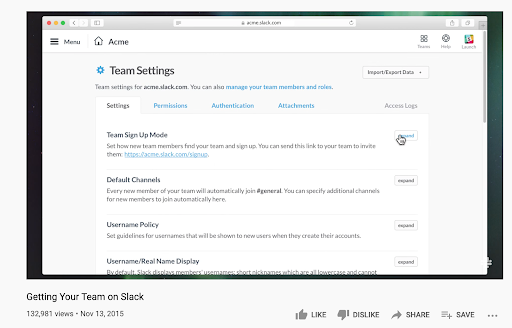
In short, make sure your onboarding video includes instructions for inviting team members and coworkers to use your software.
If your software isn’t designed for teams, but you have a referral rewards program, include instructions for referring friends and claiming rewards.
Use your onboarding videos to create short tutorials.
Your primary onboarding video will be a bit of a firehose of information, since it covers everything from account setup to using all the features in your software. At some point in their journey, new users will usually have a question about completing just one step of the account setup or using a single feature.
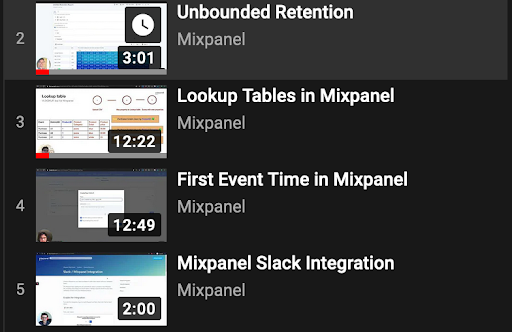
If you break your onboarding video into microlearning tutorials, users can watch a short video that shows them how to use a single feature or finish a slightly more complex step of creating their account.
This makes the information more accessible and saves users from having to skip around your longer onboarding video to find the bit they need.
Create onboarding videos for new features.
Whenever you add a new feature or make significant changes to your software, all your existing users become new users again. Suddenly, there are aspects of your software that they don’t know how to use.
Create short onboarding videos for putting new features to use. Then, deploy those same videos as tutorials for the truly new users who sign up after you’ve implemented a new feature.
This will reduce user abandonment when you make significant changes to your software and improve new user adoption. All with just one video.
Wrapping up the customer onboarding process
Video is an excellent onboarding tool. But ultimately, onboarding videos are a supplement for a strong onboarding experience.
You can lean heavily on your onboarding videos. But it’s critical that your software delivers an inline onboarding process and walkthrough, and that you have other onboarding resources, such as an FAQ page and ways to get help built into your UI.
With a good onboarding experience and a supply of video resources, you’ll get more new users, better user adoption and loyalty, and ultimately much more ROI from your SaaS product-led growth marketing.
Want to learn more about SaaS growth and product adoption? Enroll in our free Product Adoption School below!




